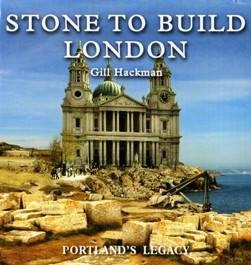 As a geologist who studied and worked in various Portland Stone buildings on both banks of the Thames, this book is a delight!
As a geologist who studied and worked in various Portland Stone buildings on both banks of the Thames, this book is a delight!
In the 1950s the author sat at her Granny’s knee to hear tell that “Portland is a special place because it is a Royal Manor and belongs to the Queen”. Granny told of her Portland ancestors and the quarrying trade that has existed, on and off, since Roman times and with London since 1350.
This is a lavishly illustrated book with 325 photos (over 75% colour) and 35 maps and diagrams. It should appeal to geologists, archaeologists, historians, building engineers and architects alike.
Part One is a brief overview, followed by Part Two (nine chapters) which cover the history of quarrying and the use of Portland Stone in London and the Empire from 1600 onwards. Part Three comprises a tour of 135 of London’s Portland Stone buildings and monuments with seven maps and 111 colour photos. For visitors to this Dorset peninsula, there follows a guide with a map and 16 colour photos. Five Appendices cover the geology, quarrying methods, exports and examples beyond London: UK, Eire, Belgium, Denmark, Japan and the USA (e.g. the Mason-Dixon monument 1751). This book reveals the history of The Isle of Portland, not only the quarrying and stone export but its interlinked land ownership and agricultural history.
There are some fascinating gems about quarrying on the Royal Manor and the use of the stone in London, especially since 1600 – in particular the impact of London’s economic and political history on the development of the Portland stone industry. Local personalities have played a fascinating role, especially in the 18th Century. Links with London scientists are mentioned, e.g. “The father of modern science” Robert Hooke, who concluded in 1665 that fossilised objects like petrified wood and fossil shells, such as ammonites, were the remains of living things, a conclusion praised by Charles Lyell in his Principles of Geology (1832).
I have often been surprised that so many buildings and memorials (e.g. war graves) could have come from such a small Dorset peninsula but Gill’s maps reveal the extent of the quarrying over the years, from coastal landslips to inland quarries and nowadays, adit mining. I estimate that quarrying has taken place over some 3.5 km
2.
Geologist, the Rev. Townsend (1813) listed the Portland Stone as the Superior Oolite – he was right in every sense!
Reviewed by Geoff Townson
STONE TO BUILD LONDON – PORTLAND’S LEGACY by GILL HACKMAN, 2014.
Published by: Folly Books Ltd; 320pp (hbk 250 x 250mm). ISBN: 978 0 9564405 9 4; List Price: £24.99. W:
www.bradford-on-avon.org.uk